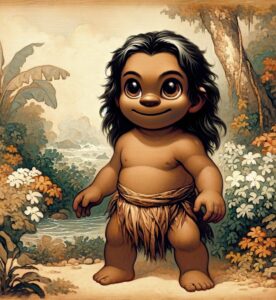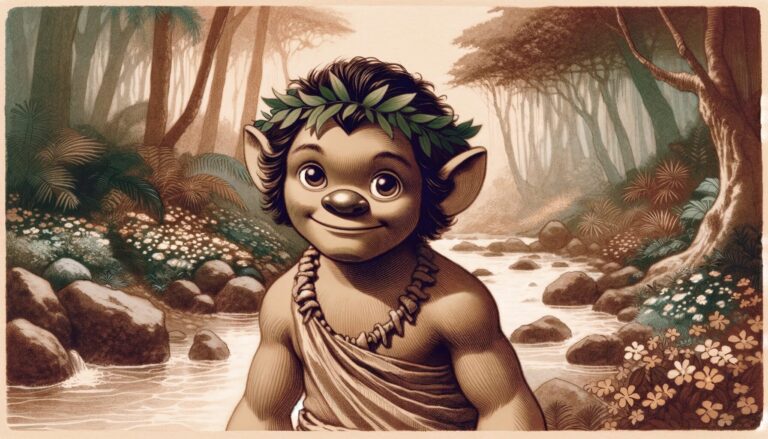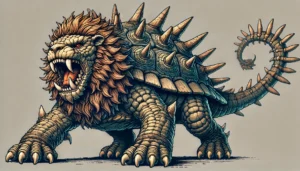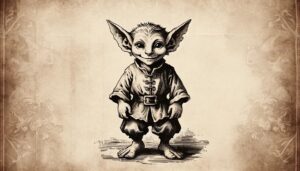Table of Contents
In the lush and enchanting landscapes of Hawaii, there exists a mythical realm teeming with mysterious beings known as the Menehune. Within this captivating setting, these diminutive creatures, steeped in the rich tapestry of Hawaiian folklore, have captivated the imaginations of generations with their intriguing stories and enigmatic presence.
Origins and Family

The origins of the Menehune are shrouded in the mists of time, making it challenging to pinpoint their exact beginnings. However, Hawaiian mythology suggests that they were the first inhabitants of the islands, predating even the Polynesian settlers. Furthermore, their lineage is said to trace back to Papa, the Earth goddess, and Wakea, the sky father. Consequently, this ancestral connection endows them with a unique status in Hawaiian mythology, as the Menehune are considered the descendants of gods.
In Hawaiian culture, the Menehune are often depicted as skilled craftsmen and builders, known for their exceptional abilities in constructing intricate structures, such as fishponds, temples, and dwellings. Their craftsmanship is said to rival that of the gods, and this remarkable talent has been passed down through generations. It is believed that the Menehune live in tight-knit communities, much like human societies, where they work collaboratively to build their homes and sustain their way of life.
Appearance
These mythical beings are typically described as small in stature, standing at only about two to three feet tall. Their physical features are said to be reminiscent of humans, with dark, tanned skin and long, flowing hair that varies in color from brown to black. Their eyes, however, are often depicted as glowing with an otherworldly light, reflecting their connection to the spiritual realm.
Menehune are known for their agility and swiftness, traits that serve them well in their daily activities and occasional interactions with humans. Additionally, their small size allows them to move stealthily through the dense Hawaiian forests, making them elusive and challenging to spot for those not attuned to their presence.
Abilities
The Menehune possess a wide array of extraordinary abilities, which set them apart as magical beings of Hawaiian mythology. These abilities are often attributed to their divine lineage and deep connection with the natural world. Some of their most renowned powers include:
Master Craftsmanship: The Menehune are renowned for their exceptional craftsmanship. They are skilled architects, builders, and artists who create intricate structures and beautiful carvings that leave onlookers in awe.
Healing Powers: These diminutive beings are believed to possess the ability to heal both physical and spiritual ailments. Their knowledge of herbal remedies and ancient healing practices is highly regarded in Hawaiian culture.
Shape-shifting: The Menehune are said to possess the ability to transform into various forms, enabling them to move stealthily through the forests and interact with humans without being detected.
Control Over Nature: Some legends suggest that the Menehune have the power to control the elements, such as wind, water, and fire. This control allows them to protect their communities and manipulate the natural world to their advantage.
Invisibility: The Menehune are often described as invisible beings who can choose when and how to reveal themselves to humans. This invisibility adds to their mystical allure and ability to remain hidden from prying eyes.
Behavior
The interactions between Menehune and humans in Hawaiian folklore vary. They are generally depicted as shy and reclusive but not necessarily dangerous. They can be friendly and helpful, as seen in stories where they assist humans in times of need, such as repairing canoes or providing healing remedies. However, they prefer to remain hidden and may become mischievous or protective if their hidden world is disturbed or disrespected. So, while they are not inherently dangerous, it’s important to approach their world with respect and reverence to maintain a positive relationship with the Menehune.
Symbols

The Menehune are represented by various symbols and motifs that reflect their significance and influence on the islands’ mythology. Some of the notable symbols associated with the Menehune include:
The ‘Ie ‘Ie Vine: This vine, known for its heart-shaped leaves, is often associated with the Menehune. Legend has it that these mythical beings used the ‘ie ‘ie vine to construct their intricate structures and traps in the forests.
Kukui Nut: The kukui nut, with its smooth, shiny surface, is considered a symbol of the Menehune’s craftsmanship. It is believed that they used kukui nuts to make lanterns that would light their way during nighttime activities.
Stone Tools: Stone tools and implements, such as adzes and hammers, are often linked to the Menehune’s construction prowess. These tools were used to shape and carve the stones used in their impressive creations.
Fishponds: Fishponds, a hallmark of Menehune construction, are often depicted in Hawaiian art and legends as a testament to their engineering skills. Moreover, these fishponds are considered enduring evidence of the Menehune’s presence and craftsmanship.
Fairy Circles: Circular formations of stones or other natural materials are sometimes associated with the Menehune. Additionally, these formations are believed to be the remnants of Menehune gatherings or ceremonial sites.
Myths and Stories
The Night Marchers. One of the most well-known Menehune legends revolves around the Night Marchers. In this eerie tale, it is a ghostly procession of ancestral spirits led by Menehune chiefs. Moreover, it is believed that those who encounter the Night Marchers can be swept away to join them. Therefore, to avoid this fate, one must lay low and show respect by lying face down and not looking at them.
The Hidden Villages. Many stories tell of hidden Menehune villages deep within the Hawaiian forests. These villages are said to be meticulously constructed, with houses, temples, and fishponds that showcase the Menehune’s extraordinary craftsmanship. These elusive settlements are often depicted as both enchanting and mysterious.
The Menehune Bridge. Legend has it that the Menehune constructed a remarkable stone bridge on the island of Kauai overnight. Their work was so swift and precise that it baffled the human inhabitants, who believed it to be the result of supernatural powers. To this day, the Menehune Bridge stands as a testament to their extraordinary abilities.
The Menehune and the Canoe. In this story, the Menehune are portrayed as benevolent beings who come to the aid of a struggling fisherman. Notably, they secretly repair his damaged canoe, thereby enabling him to continue providing for his family. Consequently, through this act of kindness, the fisherman learns of their benevolence and the importance of respecting the Menehune’s hidden world.
The Dance of the Menehune. According to legend, the Menehune are known to gather by moonlight to perform a dance known as the hula. This dance is said to be a mesmerizing spectacle, showcasing their grace and agility. Those fortunate enough to witness it are said to be blessed with good fortune.
Similarities
Various mythologies and folklore around the world feature creatures similar to Menehune in terms of their looks or abilities. Here are a few examples:
Leprechauns (Irish Folklore): Leprechauns, small, bearded, and often mischievous creatures from Irish mythology, are known for their agility and their penchant for hiding pots of gold at the end of rainbows.
Additionally, Brownies (Scottish and English Folklore): Brownies, small, benevolent household spirits from Scottish and English folklore, are known for helping with chores and domestic tasks in exchange for food. They are often depicted as small, gnome-like beings.
Dwarves (Norse Mythology): Dwarves, legendary beings in Norse mythology, are renowned for their craftsmanship, particularly in forging powerful weapons and crafting intricate jewelry. They are typically portrayed as short, stocky individuals with great skill.
Hobbits (J.R.R. Tolkien’s Fiction): Hobbits, fictional creatures created by J.R.R. Tolkien in his Middle-earth works, including “The Lord of the Rings,” are small in stature. They are known for their love of comfort and often possess unexpected bravery and resourcefulness.
Nisse or Tomte (Nordic Folklore). Nisse (Norwegian and Danish) or Tomte (Swedish), small, gnome-like creatures associated with farms and rural areas in Nordic folklore, are believed to protect the property and animals but require offerings and respect in return.
Tontos (Filipino Folklore). In Filipino folklore, Tontos are small, fairy-like creatures that inhabit natural environments. Furthermore, they are known for their magical abilities and can be mischievous or helpful, depending on how they are treated.
Pukwudgies (Native American Folklore, Wampanoag Tribe). Pukwudgies, small, human-like creatures from Native American folklore, specifically the Wampanoag tribe, are known for their trickster nature and are considered both mischievous and potentially dangerous beings.
FAQ
What are their abilities?
The Menehune are believed to possess great craftsmanship skills, and they are known for building structures like fishponds and other structures with precision.
Where are they said to live?
They are said to live deep in the forests and mountains of Hawaii, away from human settlements.
What role do they play in Hawaiian mythology?
They are considered an important part of Hawaiian mythology and are often associated with the early history of the islands.
Are Menehune considered benevolent or mischievous?
Menehune are generally considered benevolent beings, but some legends depict them as mischievous or protective of their secrets.
Do people still believe in the Menehune today?
While the Menehune are primarily a part of Hawaiian folklore, some people in Hawaii may still believe in their existence or celebrate their cultural significance.





